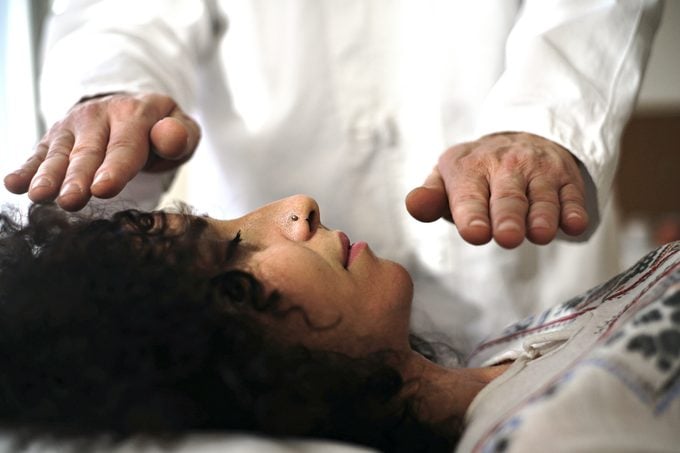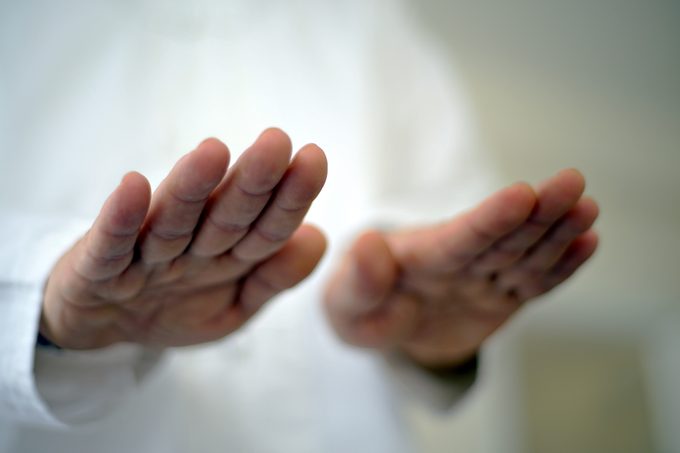What Is Reiki? Here’s What It Can—and Can’t—Do for Your Health
Updated: Apr. 26, 2021
Does Reiki work? Here's what experts have to say about the health benefits of Reiki, the energy healing practice, and how it may help relieve pain, stress, anxiety, or depression.
If you consider yourself in the know when it comes to self-care, you’ve probably heard about Reiki (pronounced Ray-key). Or perhaps you’ve already tried this energy healing practice. The truth is plenty of people have—a 2008 study from the National Center for Health Statistics suggested that 1.2 million people have tried it at least once—and that number is likely higher now.
The practice focuses on your energy balance and is used to potentially help with everything from physical pain to mental stress. It’s part of alternative and complementary medicine, which is certainly nothing new. Japanese and Chinese medicine practitioners have been using energy healing practices for hundreds of years. And one way it has emerged in the West is with the popularity of Reiki.
The origins of Reiki
The practice of Reiki dates back to the early 1900s in Japan. Matiji Kawakami created a type of energy healing in 1914 called Reiki Ryoh and published several books about it. (Although other people also practiced their own form of Reiki at the time.) In 1922, Usui Sensei developed another style of the practice, according to The International Center for Reiki Training, which set the foundation for what we know as Reiki today—although there are still many methods of Reiki healing that are available.
The name Reiki breaks down into “rei,” a Japanese word for universal life and “ki,” meaning energy, according to the International Association of Reiki Professionals (IARP). It involves gentle touch; the Reiki practitioner places their hands either just above or on a person’s clothed body and uses a series of hand placements to promote a feeling of well-being.
People use and practice Reiki regularly in the East and have for more than a century. However, the health benefits of Reiki are still being studied. Here’s what you need to know before you sign up for a session with a certified healer.

What the science says about Reiki
A 2018 meta-analysis published in Complementary Therapies in Clinical Practice, did suggest that Reiki may relieve pain. The review included four randomized, controlled trials that together had 104 people who were treated with Reiki and 108 control patients, and found a benefit for pain reduction.
A 2015 report published in Cochrane Systematic Reviews looked at three randomized studies of Reiki for the treatment of anxiety and depression or both. The researchers found it had no clear benefits but also no harmful effects, and they concluded that there was “insufficient evidence” to determine if Reiki was helpful for people over 16 with these conditions. However, the combination of Reiki with traditional counseling may help alleviate anxiety, according to a 2019 observation of four people published in the Journal of Creativity in Mental Health.
There is “reasonably strong support” that Reiki is more effective than a placebo, according to a 2017 report in the Journal of Evidence-Based Integrative Medicine. The author looked at 13 studies and found eight showed a benefit over placebo, four found no difference, and one showed clear evidence that it was no better than a placebo. (Learn what happens to your body when you actually relax.)
So, the science on the benefits of Reiki seems mixed, but what do the experts think?
What the experts say about Reiki
“Reiki is one of many ‘fringe’ topics in integrative medicine—it’s controversial, but there’s lots of public interest,” says Elizabeth Ko, MD, assistant clinical professor of medicine of the David Geffen School of Medicine and medical director of the UCLA Health Integrative Medicine Collaborative, in Los Angeles. “We, as a committee, recently reviewed the topic in detail and came to the conclusion that there simply isn’t enough quality research to support its use. That said, the practice carries very little side effects. I don’t advocate for its use, but I also don’t advocate against it… there may be a benefit, even if it stems from a placebo effect!”
Ann Marie Chiasson, MD, MPH, the director of fellowship in integrative medicine at the Andrew Weil Center for Integrative Medicine in Tucson, mentions that Reiki can be particularly helpful for those with chronic pain. “Chronic pain is different than acute pain,” says Dr. Chiasson, explaining that chronic pain usually lasts at least three months, and it affects the brain differently than acute. For example, more pain receptors turn on when you have chronic pain and signals in the brain that tell the pain to stop, don’t fire as frequently.
With chronic pain, touch is helpful, which is why Reiki may be beneficial, she says. It puts the body and brain in a relaxed state. “In the paradigm of energy healing, pain is blocked energy. So you need movement or touch to move that energy block,” she explains. “You don’t want to touch right on the spot of pain, but more upstream to move the energy.”
(What are chakras? Find out more about this type of energy healing.)
What happens in a Reiki session
So while experts recognize that more research on the health benefits are important, Natalie L. Dyer, PhD, research scientist at Kripalu Center for Yoga and Health in Stockbridge, Massachusetts still advocates for the positive effect Reiki can have on pain, stress, anxiety, and depression. (Dyer conducted Reiki research as a postdoc fellow at Harvard University.)
At its base, Reiki is an energy-based healing technique, which often incorporates touch therapy. “Reiki is all about the use of attention and intention,” says Dyer. Put simply, you’ll lie down on a table and the healer will place their hands on your body or just above you in an effort to direct your energy toward healing. “The Reiki practitioner may visualize or draw symbols in the air at the beginning of a session—what matters is the ability to focus one’s attention with intention to allow the energy to flow,” Dyer explains. “The practitioner may guide the client to breathe more deeply or to imagine they are surrounded by light. Again, these all help to strengthen the intention and focus attention.”
During the session, you should feel a deep relaxation, as Reiki is meant to kickstart the relaxation response, she says. Sometimes people can even access deep emotions, memories, or insights to promote personal healing. (Check out these alternative medicine treatments doctors recommend.)

The rise of emotions
According to the National Center for Complementary and Integrative Health, Reiki has no known side effects. However, Dyer mentions an internal debate inside the Reiki world. Some practitioners believe clients may feel slight discomfort in the minutes or weeks after a session.
“The idea is that uncomfortable, suppressed emotions, physical sensations, or beliefs may be brought to the surface of consciousness to be processed and healed. This can be an uncomfortable experience, kind of like a Reiki hangover,” Dyer explains. “However, this isn’t the norm and most people leave a session feeling much better.”
“The idea behind Reiki and other forms of energy medicine is that in order to be healthy, our life force energy must flow in a balanced way. So when the energy shifts toward rebalancing we can sometimes feel sensations of light-headedness, nausea, or exhaustion, for example,” Dyer adds. But not all patients (or even practitioners) have experienced this effect.
Dr. Chiasson also mentions that some people with chronic pain can get a flare-up after a Reiki session or 24 hours later, but if you keep going regularly that reaction subsides.
If you do have a negative experience, it will likely come up right away or as Dr. Chiasson mentioned, pain can intensify up 24 hours later. But to gain any benefits, she also mentions you should continue regular sessions. She suggests going once every 10 days, two weeks, or once a month—not more than once a week at most. (Here are some breathing techniques that help control chronic pain.)
Who should try Reiki
Anyone can try Reiki, no matter their age, gender, or belief systems, Dyer says. But she does note that women may be more likely to try it than men. They tend to be more open in general to trying complementary and alternative medicine or mind-body practices, like yoga, according to Dyer. Those who already have a regular meditation or yoga practice might see the best results, though no science has looked at this specific connection. “I would hypothesize that, as a practitioner, meditation practice would enhance the effectiveness of Reiki because it cultivates the ability to focus,” Dyer says.
Dr. Chiasson adds that anyone with chronic pain should mention their condition to the practitioner before they start a session, as too much energy could cause a flare-up. The same goes for those with fibromyalgia, as well as diabetes, as it may also lower blood sugar. Don’t be afraid to speak up to your practitioner, letting them know what’s going on in your body. (Here are questions you should ask your doctor, too.)

How to find a good Reiki practitioner
There are currently more than 2,400 Reiki practitioners listed on the IARP website. Dyer and Dr. Chiasson say word of mouth is a good way to find the right person—you may prefer to see a Reiki professional who your friend recommends. There’s also the importance of experience, Dr. Chiasson explains. “Look for someone who has been doing it for at least three years, 10 is even better,” she says. “The training is so varied that it’s good to find someone with experience.”
Also, she adds, look out for people who over-promise; for example, practitioners shouldn’t guarantee that they can heal a lifetime’s worth of anxiety. And beware if they call out something “terrible” going on in your body. “The practitioner should not have much ego involvement. For example, they should know that they are facilitating the healing but are not the source of the healing,” Dyer says. “In other words, life force energy is something we all have access to, it is not special to one person or a group of people.”
You should be able to tell if the healer is right for you from their initial touch. “Trust your evaluation of their touch—if you feel good and relaxed, that’s good. If not, then don’t go back,” Dr. Chiasson advises. “You should be relaxed during and after and in a bit of trance state.”
If you need a place to start looking for a healer, check out Reiki.org or IARP.org.
Go in with an open mind
Finally, remember to enter a Reiki session with an open mind, but a focused one. And make sure to tell your practitioner if you have anything going on in your body, particularly an underlying health condition. “A good healer, with experience, will know how to work with that,” Dr. Chiasson says.
Also, find a Reiki practitioner you can afford. Many will have a sliding fee scale if you ask, Dr. Chiasson says, so check around to find one who fits your budget. (Learn how to sneak more mindfulness into your everyday life.)
Reiki is one of the least studied Japanese energy medicine practices, says Dyer. Things like acupuncture and Qigong have more science to back up the benefits, though that could change as more people become curious or want to test out the practice. (Learn how one woman used Qigong to heal after her battle with breast cancer.)
“Until then, Reiki is best approached as an effective complementary practice to promoting wellness, rather than a standalone treatment or cure for disease,” Dyer says.










